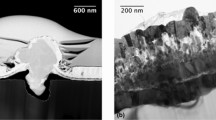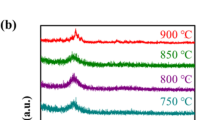Abstract
In order to study (i) how the in-plane stress develops in alkoxide-derived oxide gel films on heating and (ii) how the residual stress changes with firing temperature, we prepared titania and silica gel films on Si(100) wafers from alkoxide solutions. The intrinsic stress was previously measured in situ during heating up to 500 °C for the gel films, where the stress was calculated from the radius of curvature of the substrate bending. Because the commercialized apparatus that measures the substrate bending has an upper limitation of temperature at 500 °C, we devised a method for estimating the intrinsic stress over 500 °C in the present work. The gel films were heated from 100 °C up to 900 or 1000 °C successively and cumulatively. Then we estimated the intrinsic stress over 500 °C by monitoring the changes in stress in situ during heating and cooling for the cumulatively fired films. Combining the estimated data over 500 °C with those measured below 500 °C, we found that the intrinsic stress increases and then decreases around to zero with temperature for both titania and silica gel films, which we recognized as a general trend in alkoxide-derived oxide thin films in conjunction with our previous work on yttria stabilized zirconia (YSZ) films. Regarding the residual stress, the titania and silica films exhibited different behaviors. The titania film showed an increase followed by a slight decrease, and finally a significant increase in residual tensile stress with increasing firing temperature. The silica films also exhibited an increase and a decrease in residual tensile stress with increasing firing temperature, but the stress continued to decrease and turned into compressive one at ca 800 °C. The last decrease in residual tensile stress that turned into compressive one resulted from the development of compressive thermal stress during cooling, which is due to the smaller thermal expansion coefficient of silica than silicon. It was thus clarified that the difference in thermal expansion coefficient between the film and the substrate becomes prominent in residual stress when the films are fired at high temperatures like 800 °C. Thus we could successfully obtain a general view on how the residual stress changes with firing temperature as well as on how the in-plane stress develops during heating thanks to the information on the stress development in the sol–gel-derived titania and silica films that was added to the information on the YSZ films.

Highlights
-
In-plane stress development was studied on alkoxide-derived titania and silica thin films on Si(100) wafers by measuring the substrate bending using a commercialized apparatus.
-
We devised a method to estimate the changes in intrinsic stress during heating over 500 °C, which is the upper limit of temperature available for the apparatus.
-
Employing the estimated values we found that in-plane tensile stress develops during heating, followed by a decrease down around to zero with increasing temperature for alkoxide-derived oxide thin films.
-
The residual stress was demonstrated to be tensile at lower firing temperatures, followed by a decrease with increasing firing temperature, and finally to increase or decrease with turning into compressive one, depending on the difference in thermal expansion coefficient between the film and the substrate.








Similar content being viewed by others
References
Dislich H (1971) Angew Chem Intern Ed 10:363–370
Kozuka H (2006) J Sol-Gel Sci Techn 40:287–297
Kozuka H (2018) In: Klein LC, Aparicio M, Jitianu A (eds) Handbook of sol-gel science and technology, 2nd edn. Springer International Publishing AG, Basel, p 275–311
Ma BH, Liu SS, Tong S, Narayanan M, Balachandran U (2012) J Appl Phys 112:114117
Tsvetkov N, Lu QY, Chen Y, Yildiz B (2015) ACS Nano 9:1613–1621
Stoney GG (1909) Proc R Soc Lond A 82:172–175
Hoffman RW (1966) In: Hass G, Francombe MH, Hoffman RW, Vossen JL (eds) Physics of thin films, vol 3, Academic Press, New York, p 211–273
Kozuka H, Komeda M (2004) J Ceram Soc Jpn 112:S223–S227
Kozuka H, Iwase T (2009) J Mater Res 24:2511–2519
Yahata R, Kozuka H (2009) Thin Solid Films 517:1983–1988
Ishikawa Y, Kozuka H (2004) J Ceram Soc Jpn 112:S228–S233
Kozuka H, Miyake H, Ishikawa Y (2004) In: Proceedings of XX international congress on glass, Kyoto, Sept 27–Oct 1, paper O-11-013
Kurisu T, Kozuka H (2006) J Am Ceram Soc 89:2453–2458
Cop P, Kitano S, Niinuma K, Smarsly BM, Kozuka H (2018) Nanoscale 10:7002–7015
Rabier J, Renault PO, Eyidi D, Demenet JL, Chem J, Couvy H, Wang L (2007) Phys Stat Sol 4:3110–3114
Ohno K, Uchiyama H, Kozuka H (2012) J Appl Phys 111:014901
Brantley WA (1973) J Appl Phys 44:534–535
Akase A, Ryoke T, Kozuka H (2009) J Am Ceram Soc 92:1951–1958
Cullity BD (1953) Elements of x-ray diffraction. Addison-Wesley Publishing Company. Reading, p 262
Ohya Y, Saiki H, Tanaka T, Takahashi Y (1996) J Am Ceram Soc 79:825–830
Committee of Fain Seramikkusu Jiten (1987) Fain seramikkusu jiten (Fine ceramics dictionary). Gihodo, Tokyo, p 317
Kingery WD, Bowen HK, Uhlmann DR (1976) Introduction to ceramics. John Wiley & Sons, New York, p 662
Hummer DR, Heaney PJ, Post JE (2007) Powder Diffr 22:352–357
Reeber RR, Wang K (1996) Mater Chem Phys 46:259–264
Kikuchi Y, Sudo H, Kuzuu N (1997) J Appl Phys 82:4121–4123
Acknowledgements
This work is supported by JSPS KAKENHI Grant number JP19K22070.
Author information
Authors and Affiliations
Corresponding author
Ethics declarations
Conflict of interest
The authors declare that they have no conflict of interest.
Additional information
Publisher’s note Springer Nature remains neutral with regard to jurisdictional claims in published maps and institutional affiliations.
Supplementary material
Rights and permissions
About this article
Cite this article
Nakanishi, S., Kojima, R. & Kozuka, H. In-plane stress development in sol–gel-derived titania and silica thin films on Si(100) substrates. J Sol-Gel Sci Technol 93, 506–516 (2020). https://doi.org/10.1007/s10971-019-05212-y
Received:
Accepted:
Published:
Issue Date:
DOI: https://doi.org/10.1007/s10971-019-05212-y




